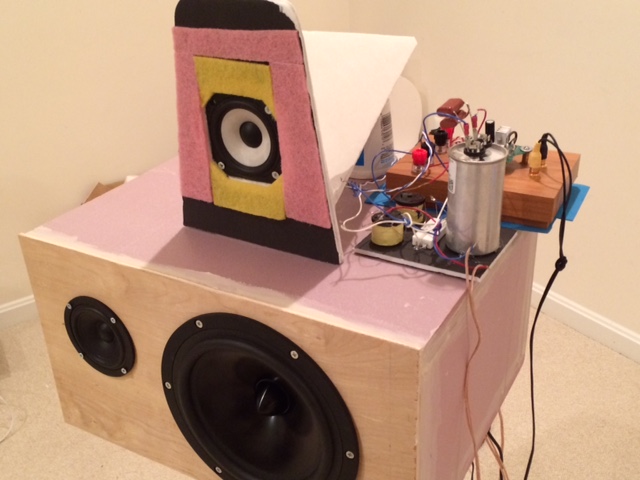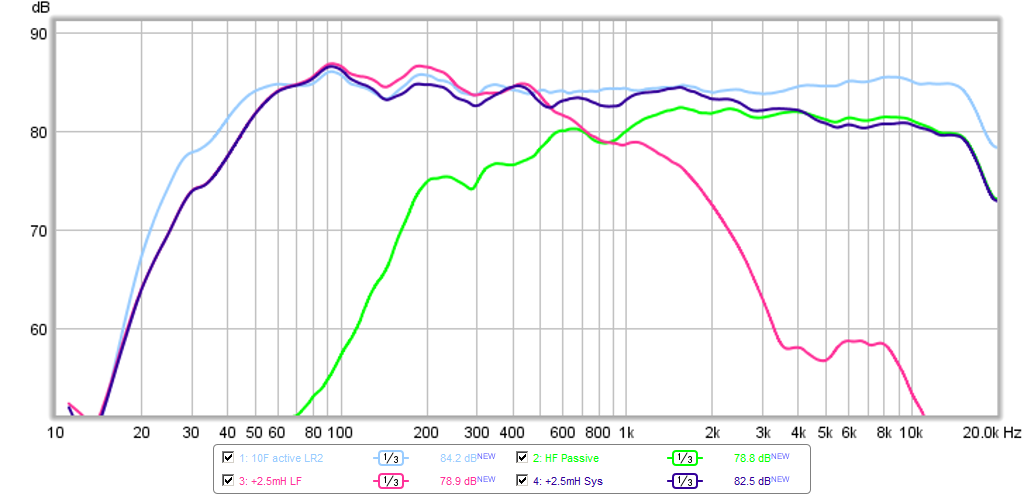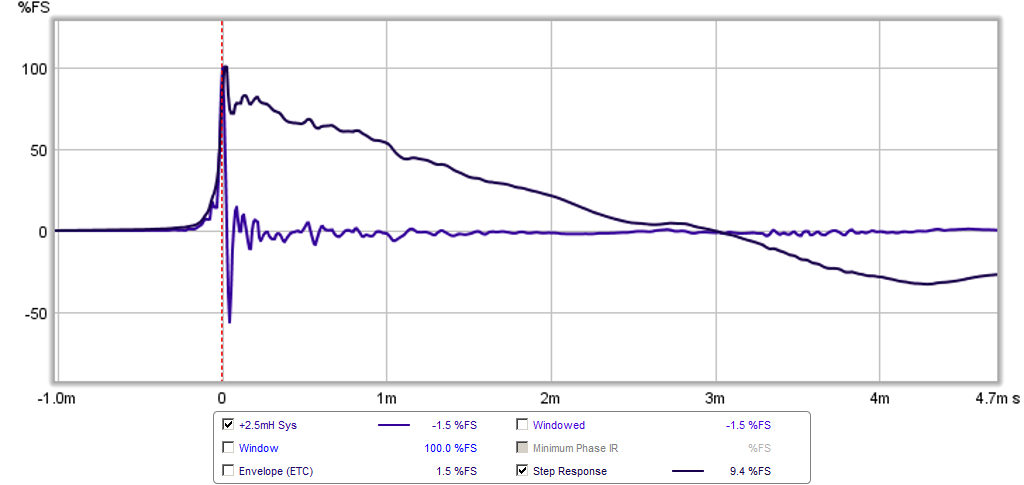for a tweeter on the cheap which plays cymbals decently, I'd use a modest compression driver and K-tube. It would be good to have a list of recordings where cymbal are predominant and well recorded for testing.
I prefer the treble of an extended full range driver to a dome tweeter - which I never liked. Domes always sound mechanical and wispy to me. Almost like they need to be larger to correctly reproduce the weight and scale of a cymbal.
Yes, I know what you mean about the wispy sound, but I still prefer the dome. Some nice domes used right don't really sound wispy to me, like the ScanSpeak D2608/9130 that I'm listening to right now. To each his own though.
There's always larger domes and cone tweeters, but they have their own problems
Domes always sound mechanical and wispy to me. Almost like they need to be larger to correctly reproduce the weight and scale of a cymbal.
Yes. I usually call that characteristics as "soft". Not many dome tweeters can do what I want in reproducing the cymbal (as a splash of metals). And even when the tweeter is capable (expensive ones only ime), it is not obvious how to make it possible.
But I have this cheap dome tweeter with dome made of yellowish woven material (which I think is metal) and big magnet who can produce "harsh/wild" sound that doesn't sound fatiguing as it seem. May be I will try to move this dome material to a more expensive tweeter magnet.
I still don't feel that a full range reproduces the treble as accurately as a tweeter, I suppose it just has something to do with the speed needed and the weight of the cone. Not to mention the beaming of a FR driver which is just as big of an issue to me.
I still don't know the reason why;
The 10F has a "sufficient" treble response by looking at the FR measurement, but from the recent blind test I found out that sound-wise it is not sufficient. Of course I trust my ears. I made a guess that it could be an excessively high non-linear distortion at the end of it's useful bandwidth.
Beaming shouldn't be the issue as the clip was already recorded near-field.
Speed of the heavy cone?? It seems not the answer also...
I still don't know the reason why;
The 10F has a "sufficient" treble response by looking at the FR measurement, but from the recent blind test I found out that sound-wise it is not sufficient. Of course I trust my ears. I made a guess that it could be an excessively high non-linear distortion at the end of it's useful bandwidth.
Beaming shouldn't be the issue as the clip was already recorded near-field.
Speed of the heavy cone?? It seems not the answer also...
Maybe I misunderstand, but I would think beaming would likely be a large part of the problem. Power response is closer to what you actually hear than the on axis frequency response.
Also, a 3" driver is going to breakup lower than a 1" dome, no matter how well controlled it might be. Most tweeters have very low distortion on the high end that start to rise dramatically around 2k. Most good small mids have low distortion in the 300-3k range and distortion starts to rise higher up as a response to breakup and other factors. This is why I like a mid to cover the midrange and a tweeter to cover the highs, it just makes sense to me. Of course it seems like many in the FR croud aren't interested in distortion measurements, but more the magic that a single driver can give you.
(good) cymbals possess a lot of energy - stand three feet from one when playing bass and then one will find out 😛 -- like to know which recordings do them justice. Paper cone tweeters can be pleasant such as 70's JBL - too bad there's not a great clone of that tweeter. I kinda remember some spit from a Dynaudio D28 on Michael Hedges - was it the dome or the CD?. Are some of Charly Antolini's recordings pretty good with high hat, crash and ride? Steve Clarke's "Solo Drums" puts a lot of emphasis on tom rolls.
Does someone have a favorite track with lots of cymbals ? I will record it with the 10F FAST vs the soft dome tweeter in the LSR305 and post the sound clip.
I've been working at following this post, but you smart guys use terms I depend on you to dumb-down for me. I have a pair of RS-225's I'd like to use in this type of set-up. So far, I've only picked up that you are using a DSP for your crossover. Not having a DSP, but having a fairly good supply of inductors, caps, and resistors, I'm hoping your findings can be translated to a passive crossover. I haven't decided on the FR driver yet, but am I offf base with my hopes? I'm hoping to keep it as simple as possible, being that it will be a FAST. However, the real goal is something that sounds good.
Thanks for all the sharing and advice you guys offer.
Mike
Thanks for all the sharing and advice you guys offer.
Mike
Didn't see a review on those LSR305, X.
What's up? You're getting old? You're slowing down? 😉
I was expecting a quick review! 🙂
What's up? You're getting old? You're slowing down? 😉
I was expecting a quick review! 🙂
Didn't see a review on those LSR305, X.
What's up? You're getting old? You're slowing down? 😉
I was expecting a quick review! 🙂
Did you want more than this?
http://www.diyaudio.com/forums/full...-rs225-8-fast-ref-monitor-45.html#post4347377
I've been working at following this post, but you smart guys use terms I depend on you to dumb-down for me. I have a pair of RS-225's I'd like to use in this type of set-up. So far, I've only picked up that you are using a DSP for your crossover. Not having a DSP, but having a fairly good supply of inductors, caps, and resistors, I'm hoping your findings can be translated to a passive crossover. I haven't decided on the FR driver yet, but am I offf base with my hopes? I'm hoping to keep it as simple as possible, being that it will be a FAST. However, the real goal is something that sounds good.
Thanks for all the sharing and advice you guys offer.
Mike
There have been a number of passive crossovers implemented with values listed and measurements. Read back over the last 10 pages or so. They're of course only going to be valid to you if you use the same mid and baffle layout.
Depending on driver choice, slopes and xo point, the xo can be fairly simple to a pain in a**, or impossible. DO you have and modeling software and a way to measure the drivers?
If you decide on a different mid, maybe I can help get you started on a passive xo for it. Just let me know.
WHich RS225 did you get?
You might look at the dayton RS100P. extended, smooth response on and off axis. good motor with decent xmax to help with these low crossovers and should be a good sensitivity match. All at a pretty decent price
I've been working at following this post, but you smart guys use terms I depend on you to dumb-down for me. I have a pair of RS-225's I'd like to use in this type of set-up. So far, I've only picked up that you are using a DSP for your crossover. Not having a DSP, but having a fairly good supply of inductors, caps, and resistors, I'm hoping your findings can be translated to a passive crossover. I haven't decided on the FR driver yet, but am I offf base with my hopes? I'm hoping to keep it as simple as possible, being that it will be a FAST. However, the real goal is something that sounds good.
Thanks for all the sharing and advice you guys offer.
Mike
Mike,
In post 439, I show how a passive xo can work. It works quite nicely in fact as it is able to achieve a transient perfect step response. However, you need to physically mount the full range driver with a 3inch setback for proper time alignment. So it won't be a rectangular box and flat baffle. It will most likely have the Dagger in a separate cabinet sitting on top of the sealed woofer.
I can draw the xo diagram for you if you did not figure it out based on verbal descriptions. The xo is a first order Butterworth parallel topology. Use a 57uF cap for the tweeter padded down with a 5R+5R resistor divider with the mid tap connected to the tweeter positive. The RS225-8 is low passed with a simple circa 6.2 mH inductor. That's it, however, if you want to extract max performance - you should measure the free running response in the cabinet and use a program like PCD or xsim to calculate values and also to shape it. I have presented an alternative that can work and sounds quite nice - super even.

Here is the response with a TG9FD (8ohm) driver for the full range.

Last edited:
Did you want more than this?
http://www.diyaudio.com/forums/full...-rs225-8-fast-ref-monitor-45.html#post4347377
Yikes!
Sorry, missed that one!
Thanks!
X, is the TG9fd mounted open baffle or is it in an enclosure? It looks open in the picture.
You really should try the zobel(ish) across the woofer. It'll make a big difference in getting the xo down where you want it and it might help some of the low end cancellation.
You really should try the zobel(ish) across the woofer. It'll make a big difference in getting the xo down where you want it and it might help some of the low end cancellation.
Mike,
In post 439, I show how a passive xo can work. It works quite nicely in fact as it is able to achieve a transient perfect step response.
how are you generating the step in REW? I don't remember seeing a way to do that. and what does the blue line stand for on the graph
And is a perfect step response everything though? You have some pretty bad phase issues there along with insufficient suppression of the metal cone breakup. I would think these would be much more audible than the perfect step.
Maybe I misunderstand, but I would think beaming would likely be a large part of the problem. Power response is closer to what you actually hear than the on axis frequency response.
What I meant was:
I heard issues when listening to the 10F recorded clip. Whatever the power response of the 10F, it is represented by the frequency response at which position it is recorded. And the flat FR means there was no issue with beaming, or precisely is irrelevant.
Beaming could only happen in my listening space, but that's not from 10F but from my speaker, which is not FR.
I've been working at following this post, but you smart guys use terms I depend on you to dumb-down for me. I have a pair of RS-225's I'd like to use in this type of set-up. So far, I've only picked up that you are using a DSP for your crossover. Not having a DSP, but having a fairly good supply of inductors, caps, and resistors, I'm hoping your findings can be translated to a passive crossover. I haven't decided on the FR driver yet, but am I offf base with my hopes? I'm hoping to keep it as simple as possible, being that it will be a FAST. However, the real goal is something that sounds good.
Thanks for all the sharing and advice you guys offer.
Mike
X, is the TG9fd mounted open baffle or is it in an enclosure? It looks open in the picture.
You really should try the zobel(ish) across the woofer. It'll make a big difference in getting the xo down where you want it and it might help some of the low end cancellation.
The TG9FD is mounted in a Dagger TL with a vented tail and stuffed with fiberglass. The Dagger is mounted to a trapezoid baffle surrounded with Scotchbrite pads (it works!).
In REW under the Inpulse Response tab, there is checkbox at bottom for Step Response.
What blue line are asking about?

Last edited:
What I meant was:
I heard issues when listening to the 10F recorded clip. Whatever the power response of the 10F, it is represented by the frequency response at which position it is recorded. And the flat FR means there was no issue with beaming, or precisely is irrelevant.
Beaming could only happen in my listening space, but that's not from 10F but from my speaker, which is not FR.
Ah, ok. I didn't know you meant listened to a recorded clip.
What I've noticed while listening to a few of those clips is a bit of unpleasantness overall. I think it just has to do with the unnatural sound of a recording of recording. I can hear differences between drivers, but it's hard to know if that's the drivers or the recording conditions. It would help if the they were all equalized to flat, but then we probably wouldn't hear any difference at all without listening to the drivers in person.
The TG9FD is mounted in a Dagger TL with a vented tail and stuffed with fiberglass. The Dagger is mounted to a trapezoid baffle surrounded with Scotchbrite pads (it works!).
In REW under the Inpulse Response tab, there is checkbox at bottom for Step Response.
What blue line are asking about?

Haha, I was gonna ask what's up with those colors, did you make it on Easter?
The light blue line near the summed response in the rs225/tg9fd passive graph
- Home
- Loudspeakers
- Full Range
- 10F/8424 & RS225-8 FAST / WAW Ref Monitor